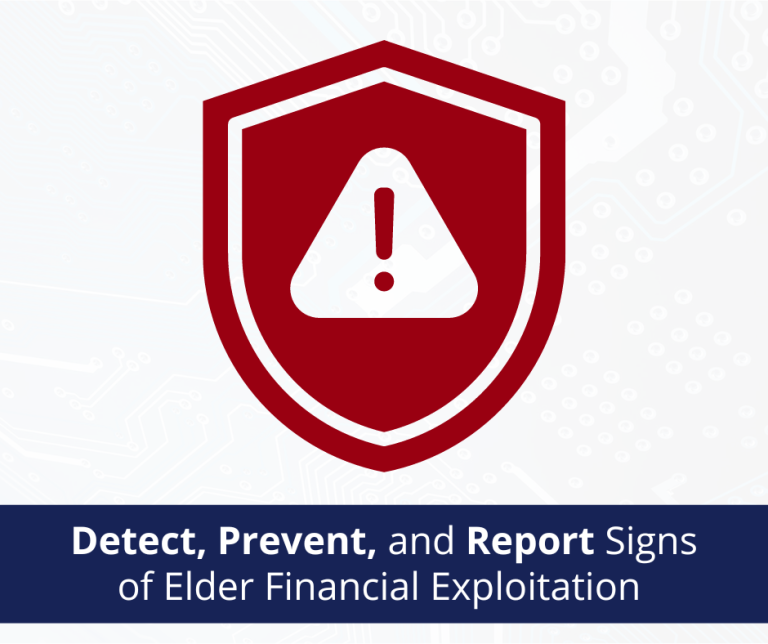As consultants to registered investment adviser (RIA) firms, we understand the importance of educating staff and affiliated advisers on the signs of financial exploitation and scams when dealing with elderly clients. Elderly investors are common targets of financial fraud and scams, most often due to diminished capacity, cognitive decline, and living arrangements lacking frequent social interaction. In this blog post, we list three steps investment advisers can take to detect, prevent, and report suspected instances of elder abuse.
By definition, financial exploitation occurs when an abuser uses a victim’s money without permission or through manipulation and fear. As advisers build relationships with their clients, they should have a general understanding of their clients’ financial goals and investing habits. This knowledge and awareness are key to identifying suspected red flags for financial exploitation.
Investment advisers have a fiduciary responsibility to act in their clients’ best interests at all times. In some states, the law requires advisers to address suspected fraud and financial exploitation by reporting such suspicions to the state department where the client resides.
We cannot emphasize enough the importance of a firm to implement actionable policies and procedures, and ensure their staff is properly trained to identify and respond to suspected elder abuse. RIA in a Box’s Director of Compliance Jason Vinsonhaler, created this three step guide for detecting, preventing, and reporting elder abuse.
1. Don’t accuse
Refrain from making accusations directly to the suspected abuser or even addressing concerns with the client. Rather, observe, document and report the flagged behavior to the appropriate authorities, and wait for further instructions. If the client has appointed a “trusted contact” (who is not the individual under suspicion), you may also wish to notify them.
Direct accusations may worsen or streamline the abuse, or encourage the abuser to remove any contact between the firm and your client. When it comes to situations as serious as elder abuse, it’s best to report and defer to trained authorities and report the suspicions to the state department where the victim resides. You’ll also want to be sure to stay within federal regulations in your approach to reporting suspected abuse.
To learn more about the regulations and specific state requirements regarding reporting elder abuse, you can reference the Senior Safe Act fact sheet, created and distributed through collaboration with the North American Securities Administrators Association (NASAA), the Securities and Exchange Commission (SEC) and the Financial Industry Regulatory Authority (FINRA).
The act offers liability protections to financial professionals who face barriers to reporting suspected senior financial exploitation. We highly encourage chief compliance officers (CCO) and other investment adviser firm members to carefully review the Senior Safe Act fact sheet in its entirety, given the continued regulatory focus on senior investor protection and exploitation.
2. Know the warning signs
RIAs must educate their staff on the warning signs of elder abuse and financial exploitation. As mentioned earlier, investment advisers are in a unique position to identify both cognitive decline in a client and potential fraud signs.
Recognizing red flags is the key to early abuse detection and prevention. Some red flags can be spotted through financial activity, such as:
- Erratic or uncharacteristic transactions.
- Frequent, large withdrawals.
- Unpaid bills or financial mail redirected to a different address.
- Suddenly closed accounts, especially those which incur penalties.
- Suspicious signatures on accounts or new names added to accounts.
While these actions certainly don’t confirm elder abuse, they should encourage advisers to look closer at their client’s financial situation for further warning signs.
Other red flags come directly from clients and/or their caregivers. These can include:
- An inability to speak directly with the elderly client.
- An elderly client who is unusually submissive toward their caregiver.
- A caregiver, family member or friend who attempts to insert INTO themselves into the financial planning process, often overriding or interrupting the elderly client.
3. Put strong policies in place
The last step toward elder abuse prevention within your firm is to set strong policies and procedures to directly address elder abuse.
These policies should define elder abuse, while also providing guidance on red flags. You’ll also need to include a list of actionable steps your staff can follow if they need to report suspected elder abuse. Such policies may include placing a hold on any transaction impacted by the past, current or attempted financial exploitation for a specified period.
Early detection is key to helping your clients. These steps can help you implement a system within your firm to recognize and appropriately respond to the warning signs of elder abuse.
In line with our mission to be an educational resource and partner to RIAs, our IAR Continuing Education Program offers vital information related to early recognition and prevention.
